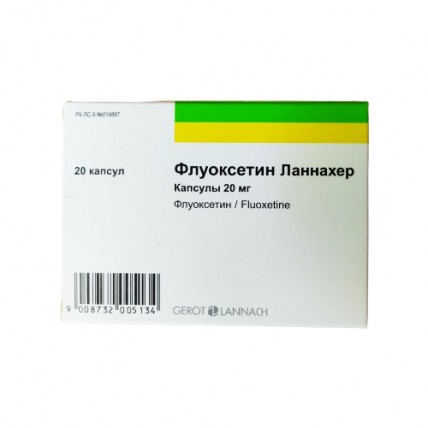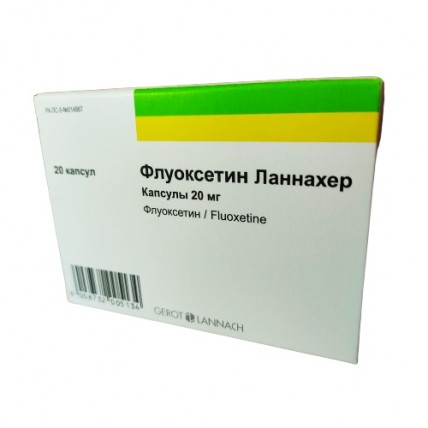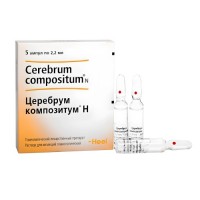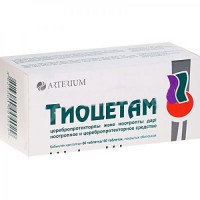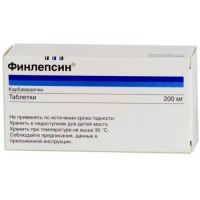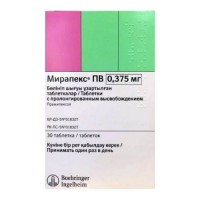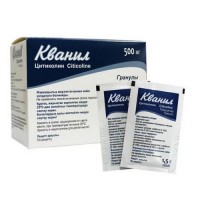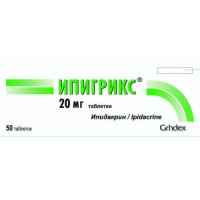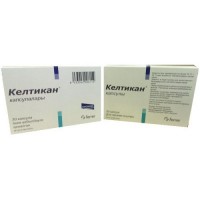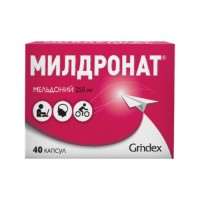Fluoxetine (Fluoxetine Lannacher) 20 mg, 20 capsules
- $23.00
Out Of Stock
Fluoxetine is a selective serotonin reuptake inhibitor used to treat major depressive disorder, bulimia, OCD, premenstrual dysphoric disorder, panic disorder, and bipolar I.
Common brand names: Act Fluoxetine, Prozac, FLUOXETINE GENERICHEALTH, Andepin, Azur, Rapiflux, Sarafem, Symbyax
One capsule contains the active substance - fluoxetine hydrochloride, equivalent to 20 mg of fluoxetine
- depression of various origins
- obsessive-compulsive disorder
- bulimia nervosa
Fluoxetine Lannacher is taken orally, without chewing, once a day, regardless of food intake, with a sufficient amount of liquid.
For depression, the initial dosage is 20 mg / day 1 time, in the morning. If after 3-4 weeks of continuous administration there is no clinical effect, the dose should be increased to 20 mg 2 times a day (morning and afternoon), the maximum daily dose is 80 mg / day. Duration of use is at least 6 months.
With bulimic neurosis, 1 capsule is prescribed 3 times a day (60 mg / day), the duration of treatment is at least 3 months.
For obsessive-compulsive disorders - 20-60 mg / day, the duration of treatment is at least 6 months.
In patients with renal and hepatic insufficiency, as well as in elderly patients, the dose of Fluoxetine should be reduced.
- itching, rash, urticaria, anaphylactoid reactions, vasculitis, Quincke's syndrome, chills, photosensitivity
- diarrhea, nausea, vomiting, indigestion, dysphagia, taste perversions, dry mouth
- headache, sleep disorders (sleep disorders, insomnia), dizziness, anorexia, fatigue, drowsiness, euphoria, transient pathological conditions (ataxia, tremor, myoclonus), convulsions and psychomotor instability, hallucinations, mania, agitation, anxiety and nervousness, decreased concentration and thought process (depersonalization), panic attacks (these signs may be part of the disease)
- dysuric disorders, sexual dysfunction (delay or absence of ejaculation, anorgasmia), priapism, galactorrhea
- hair loss, yawning
- visual impairment (fogging, mydriasis), sweating, vasodilation
- arthralgia, myalgia, postural hypotension, bruising, hyponatremia.
Seldom
- pathological changes in liver function, pharyngitis, respiratory failure.
Rarely
- toxic epidermal necrolysis (Lyell's syndrome), idiopathic hepatitis, serotonin syndrome, gynecological bleeding, gastrointestinal bleeding and other skin or mucous membrane bleeding.
- hypersensitivity to fluoxetine or any component of the drug
- severe renal failure (creatinine clearance less than 10 ml / min)
- severe liver failure
- taking MAO inhibitors (currently or in the previous 2 weeks)
- children and adolescents up to 18 years old
- pregnancy and lactation
When combined with phenytoin, changes in blood counts and toxic manifestations are observed. Concomitant use should be accompanied by careful selection of the dose of the concomitant drug and monitoring of the clinical condition.
Combination with serotonergic drugs (eg tramadol, triptan), lithium, or tryptophan may increase the risk of serotonin syndrome.
Use with triptan carries an additional risk of coronary vasoconstriction and hypertension.
Since the metabolism of fluoxetine includes hepatic cytochrome CYP2D6, concomitant therapy with drugs that are also metabolized with the participation of this enzyme leads to drug interactions and requires a decrease in their dose. This is also required if fluoxetine has been used in the previous 5 weeks.
When combined with oral anticoagulants, clotting parameters (laboratory parameters and clinical symptoms) change, including increased bleeding.
Patients receiving warfarin therapy should be monitored for coagulation when fluoxetine is prescribed or discontinued.
When using fluoxetine in conjunction with electroconvulsive therapy (ECT), lengthening of attacks is possible.
There may be a pharmacodynamic interaction between fluoxetine and an herbal remedy (St. John's wort), which can lead to an increase in unwanted effects.
Drinking alcohol is not allowed during treatment with fluoxetine.
Special instructions
Fluoxetine should be used with caution in patients with a history of seizures. Fluoxetine should be avoided in patients with unstable epilepsy, and patients with controlled epilepsy require careful monitoring.
Antidepressants should be used with caution in patients with mania / hypomania. As with any antidepressant, fluoxetine should be discontinued when the stage of mania occurs.
A reduced dose is recommended in patients with significant hepatic dysfunction.
Use with caution in acute coronary syndrome.
Weight loss can occur in patients taking fluoxetine, but is usually proportional to baseline body weight.
In diabetic patients, treatment with serotonin reuptake inhibitors alters glycemic control. Hypoglycemia occurred during fluoxetine therapy, and hyperglycemia after discontinuation of treatment. Insulin and - or oral hypoglycemic drugs need dose adjustment.
Carefully use in patients with concomitant use of anticoagulants, drugs that affect platelet function (for example, atypical antipsychotics such as clozapine, phenthiazines, aspirin) or other drugs that increase the risk of bleeding, as well as in patients with a history of bleeding.
There are reports of prolonged convulsions in patients receiving fluoxetine and electroconvulsive therapy, therefore, it is used with caution.
There is a danger of developing serotonin syndrome when used together with herbal preparations containing St. John's wort or when combined with other serotonergic drugs (among other L-tryptophan) and / or antipsychotics.
Features of the effect of the drug on the ability to drive a vehicle or potentially dangerous machinery: Patients should refrain from driving a car or dangerous equipment until there is firm confidence that their ability to concentrate has not deteriorated.
Symptoms: nausea, vomiting, seizures, cardiovascular dysfunction ranging from asymptomatic arrhythmias to cardiac slowdown, pulmonary dysfunction, and signs of central nervous system disorders ranging from agitation to coma. Severe consequences of an overdose are very rare.
Treatment: symptomatic.
Store at a temperature not exceeding 25 ° C, in a dry, dark place.
Keep out of the reach of children!
Shelf life - 3 years
Do not use the drug after the expiration date.
Common brand names: Act Fluoxetine, Prozac, FLUOXETINE GENERICHEALTH, Andepin, Azur, Rapiflux, Sarafem, Symbyax
Structure
One capsule contains the active substance - fluoxetine hydrochloride, equivalent to 20 mg of fluoxetine
Indications for use
- depression of various origins
- obsessive-compulsive disorder
- bulimia nervosa
Method of administration and dosage
Fluoxetine Lannacher is taken orally, without chewing, once a day, regardless of food intake, with a sufficient amount of liquid.
For depression, the initial dosage is 20 mg / day 1 time, in the morning. If after 3-4 weeks of continuous administration there is no clinical effect, the dose should be increased to 20 mg 2 times a day (morning and afternoon), the maximum daily dose is 80 mg / day. Duration of use is at least 6 months.
With bulimic neurosis, 1 capsule is prescribed 3 times a day (60 mg / day), the duration of treatment is at least 3 months.
For obsessive-compulsive disorders - 20-60 mg / day, the duration of treatment is at least 6 months.
In patients with renal and hepatic insufficiency, as well as in elderly patients, the dose of Fluoxetine should be reduced.
Side effects
- itching, rash, urticaria, anaphylactoid reactions, vasculitis, Quincke's syndrome, chills, photosensitivity
- diarrhea, nausea, vomiting, indigestion, dysphagia, taste perversions, dry mouth
- headache, sleep disorders (sleep disorders, insomnia), dizziness, anorexia, fatigue, drowsiness, euphoria, transient pathological conditions (ataxia, tremor, myoclonus), convulsions and psychomotor instability, hallucinations, mania, agitation, anxiety and nervousness, decreased concentration and thought process (depersonalization), panic attacks (these signs may be part of the disease)
- dysuric disorders, sexual dysfunction (delay or absence of ejaculation, anorgasmia), priapism, galactorrhea
- hair loss, yawning
- visual impairment (fogging, mydriasis), sweating, vasodilation
- arthralgia, myalgia, postural hypotension, bruising, hyponatremia.
Seldom
- pathological changes in liver function, pharyngitis, respiratory failure.
Rarely
- toxic epidermal necrolysis (Lyell's syndrome), idiopathic hepatitis, serotonin syndrome, gynecological bleeding, gastrointestinal bleeding and other skin or mucous membrane bleeding.
Contraindications
- hypersensitivity to fluoxetine or any component of the drug
- severe renal failure (creatinine clearance less than 10 ml / min)
- severe liver failure
- taking MAO inhibitors (currently or in the previous 2 weeks)
- children and adolescents up to 18 years old
- pregnancy and lactation
Drug interactions
When combined with phenytoin, changes in blood counts and toxic manifestations are observed. Concomitant use should be accompanied by careful selection of the dose of the concomitant drug and monitoring of the clinical condition.
Combination with serotonergic drugs (eg tramadol, triptan), lithium, or tryptophan may increase the risk of serotonin syndrome.
Use with triptan carries an additional risk of coronary vasoconstriction and hypertension.
Since the metabolism of fluoxetine includes hepatic cytochrome CYP2D6, concomitant therapy with drugs that are also metabolized with the participation of this enzyme leads to drug interactions and requires a decrease in their dose. This is also required if fluoxetine has been used in the previous 5 weeks.
When combined with oral anticoagulants, clotting parameters (laboratory parameters and clinical symptoms) change, including increased bleeding.
Patients receiving warfarin therapy should be monitored for coagulation when fluoxetine is prescribed or discontinued.
When using fluoxetine in conjunction with electroconvulsive therapy (ECT), lengthening of attacks is possible.
There may be a pharmacodynamic interaction between fluoxetine and an herbal remedy (St. John's wort), which can lead to an increase in unwanted effects.
Drinking alcohol is not allowed during treatment with fluoxetine.
Special instructions
Fluoxetine should be used with caution in patients with a history of seizures. Fluoxetine should be avoided in patients with unstable epilepsy, and patients with controlled epilepsy require careful monitoring.
Antidepressants should be used with caution in patients with mania / hypomania. As with any antidepressant, fluoxetine should be discontinued when the stage of mania occurs.
A reduced dose is recommended in patients with significant hepatic dysfunction.
Use with caution in acute coronary syndrome.
Weight loss can occur in patients taking fluoxetine, but is usually proportional to baseline body weight.
In diabetic patients, treatment with serotonin reuptake inhibitors alters glycemic control. Hypoglycemia occurred during fluoxetine therapy, and hyperglycemia after discontinuation of treatment. Insulin and - or oral hypoglycemic drugs need dose adjustment.
Carefully use in patients with concomitant use of anticoagulants, drugs that affect platelet function (for example, atypical antipsychotics such as clozapine, phenthiazines, aspirin) or other drugs that increase the risk of bleeding, as well as in patients with a history of bleeding.
There are reports of prolonged convulsions in patients receiving fluoxetine and electroconvulsive therapy, therefore, it is used with caution.
There is a danger of developing serotonin syndrome when used together with herbal preparations containing St. John's wort or when combined with other serotonergic drugs (among other L-tryptophan) and / or antipsychotics.
Features of the effect of the drug on the ability to drive a vehicle or potentially dangerous machinery: Patients should refrain from driving a car or dangerous equipment until there is firm confidence that their ability to concentrate has not deteriorated.
Overdose
Symptoms: nausea, vomiting, seizures, cardiovascular dysfunction ranging from asymptomatic arrhythmias to cardiac slowdown, pulmonary dysfunction, and signs of central nervous system disorders ranging from agitation to coma. Severe consequences of an overdose are very rare.
Treatment: symptomatic.
Storage conditions
Store at a temperature not exceeding 25 ° C, in a dry, dark place.
Keep out of the reach of children!
Shelf life - 3 years
Do not use the drug after the expiration date.
